Exploring Sea Turtle Lifespan: Facts and Insights
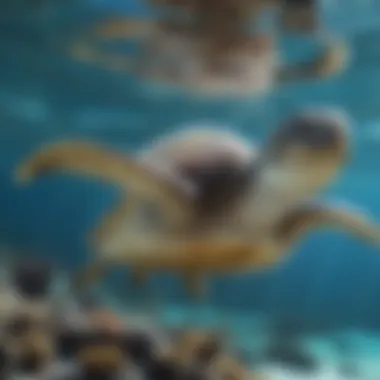
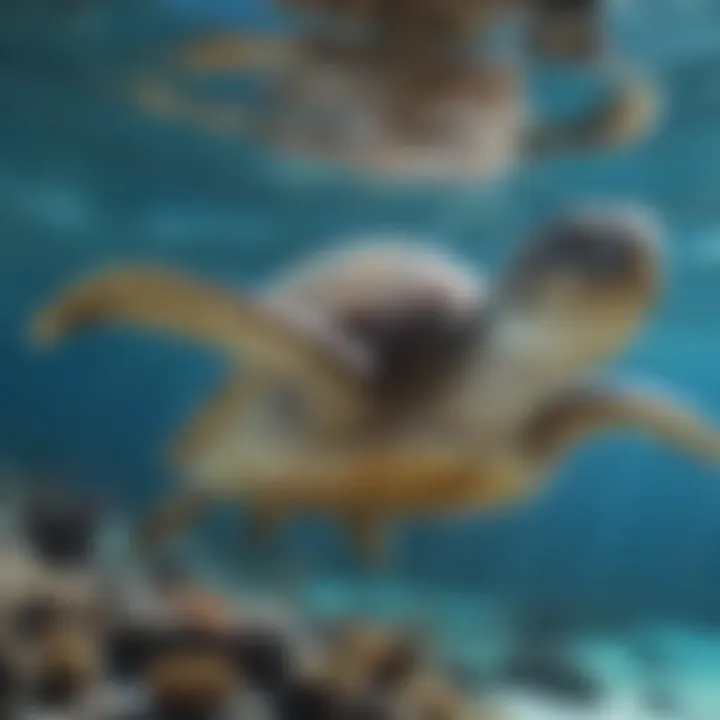
Overview of the Topic
Sea turtles are remarkable creatures, known for their long life spans and unique ecological roles. This article explores the average lifespan of various sea turtle species, offering insights into their life cycles and the factors that influence their longevity. Understanding the lifespan of sea turtles is critical for conservation efforts, as these animals face numerous threats in their natural habitats.
Sea turtles depend heavily on marine ecosystems, and their health reflects the overall state of the environment. Thus, it is imperative to grasp how different species differ in their longevity and life strategies.
Current Status and Challenges
The average lifespan of sea turtles varies significantly among species. For example, the leatherback turtle can live up to 50 years, while smaller species like the hawksbill may have a shorter lifespan of around 30 years. Unfortunately, many sea turtle populations are declining due to factors like climate change, habitat loss, and fishing practices.
"Human activity has a profound impact on the survival rates of sea turtles, altering their habitats and endangering their lives."
Some of the main challenges include:
- Habitat degradation, especially in nesting areas.
- Bycatch in commercial fishing nets.
- Marine pollution, including plastic waste.
- Climate change affecting nesting habits and temperature-dependent sex determination.
Sustainable Solutions
Efforts to protect sea turtles focus on both mitigating human impacts and promoting sustainable practices. Innovative solutions have emerged, showcasing how communities worldwide can work towards sea turtle conservation. This includes:
- Establishing marine protected areas to safeguard vital habitats.
- Implementing safe fishing practices that minimize bycatch.
- Public education programs to raise awareness about sea turtle conservation.
- Beach clean-ups to reduce plastic pollution in coastal areas.
Successful case studies, like the work done by the Sea Turtle Conservancy, demonstrate the effectiveness of these efforts and contribute to the protection of diverse species.
Impact and Importance
The significance of understanding sea turtle lifespans is vast. As vital components of marine ecosystems, sea turtles help maintain the balance of algae and seagrass beds, ultimately supporting various marine species. The decline in their populations can lead to unforeseen consequences in ocean ecosystems.
Moreover, sea turtles carry economic importance for coastal communities through ecotourism. Protecting them is crucial for future generations, ensuring they can witness these magnificent species. Conservation efforts must focus on sustainable resource use to protect sea turtles and their habitats.
Prelims to Sea Turtles
Sea turtles are fascinating creatures that play a vital role in marine ecosystems. Understanding them is important not just for scientific knowledge but also for the conservation of their species. As we explore the average lifespan of sea turtles, we will uncover insights about their biology, the unique challenges they face, and the ecological importance they hold.
Their long lives allow these reptiles to at times reach reproductive maturity and contribute to their populations. However, many factors influence their lifespans, including environmental changes and human activities. Moreover, each species exhibits different lifespans, which can vary significantly from one to another.
By studying the average lifespan of various sea turtle species, we can better appreciate the complexity of their lives and the survival challenges they contend with.
Overview of Sea Turtle Species
There are seven species of sea turtles known today. Each species possesses distinct characteristics that affect its survival and reproduction. The most recognized species include the Loggerhead, Green, and Hawksbill turtles. Understanding these species allows us to assess their individual lifespans accurately.
- Loggerhead Sea Turtle: Known for its large head and strong jaws. Loggerheads can live for several decades, often reaching 50 years or more.
- Green Sea Turtle: Named for the color of its body fat, green turtles are primarily herbivorous and can also reach impressive ages, often up to 80 years.
- Hawksbill Sea Turtle: Recognized for its unique beak-like mouth and beautiful shell. Hawksbills generally have shorter life spans than others, around 30 to 50 years.
Habitat and Distribution
Sea turtles inhabit oceans around the world, from tropical and subtropical regions to temperate ones. Their habitat can significantly affect their health and lifespan. They typically nest on coastal beaches and rely on specific environmental conditions for their survival.
- Nesting Sites: Most sea turtles return to the beaches where they were born to lay eggs, often migrating long distances to do so.
- Feeding Grounds: They prefer shallow waters rich in seagrass and algae for feeding. These areas are critical for their growth and reproductive health.
Important Note: Habitat loss due to coastal development poses a serious threat to their nesting and feeding areas, impacting population sustainability.
General Lifespan of Sea Turtles
The lifespan of sea turtles varies significantly among different species. Understanding this aspect is crucial for several reasons. First, it allows researchers and conservationists to set realistic expectations for rehabilitation and recovery efforts. It also contributes to the knowledge of population dynamics, which is essential when developing management strategies. Lifespan data is not just about numbers; it offers insights into the ecological roles these turtles play in marine environments.
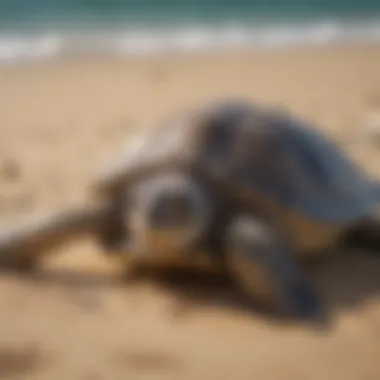
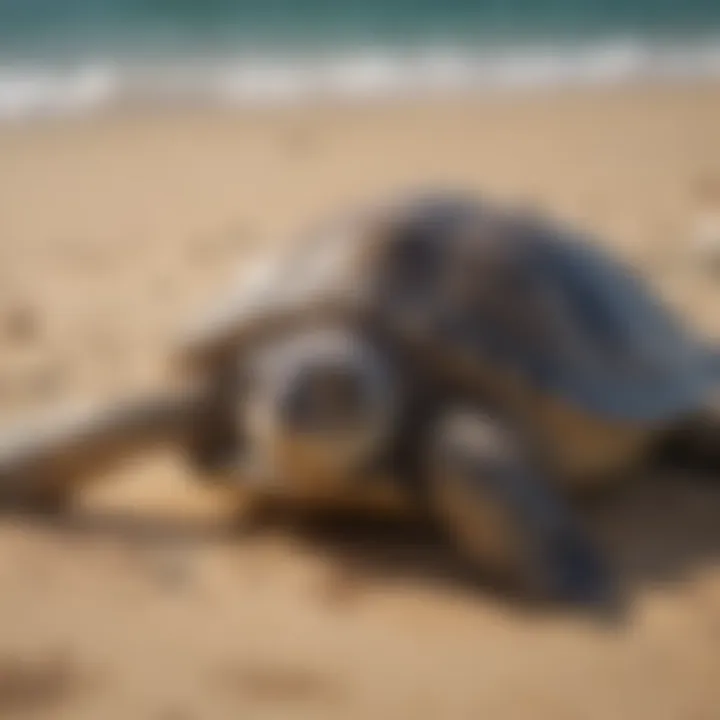
Average Lifespan Across Species
Sea turtles showcase remarkable diversity, with each species exhibiting different lifespans. For example:
- Green Sea Turtles: They typically live between 60 to 80 years in the wild.
- Leatherback Sea Turtles: Their lifespan can reach up to 50 years, although some individuals may survive longer.
- Hawksbill Turtles: These turtles have a lifespan ranging between 30 to 50 years.
These figures can fluctuate based on environmental conditions and threats. In captivity, sea turtles may live longer due to the absence of predators and improved care.
Comparative Analysis of Lifespan
When comparing sea turtles to other reptiles, their longevity stands out distinctly. For instance, land turtles often exhibit longer lifespans than sea turtles. The Aldabra giant tortoise can live over 100 years. This comparison highlights unique adaptations in sea turtles, shaped by their marine lifestyle. Factors such as
- Predation Rates: Sea turtles face various natural threats in the ocean, including sharks and larger marine animals.
- Reproductive Strategies: Many sea turtles invest in producing numerous eggs, which can influence survival rates.
Life Cycle Stages of Sea Turtles
The life cycle of sea turtles is crucial for understanding their overall lifespan and the challenges they face at various stages. Each phase of their life presents unique vulnerabilities and adaptations that influence their survival. By examining these life cycle stages, we glean insights into conservation strategies and ecological roles of sea turtles. The stage of development, from hatching to reproductive maturity, outlines the journey these reptiles undertake, highlighting the impact of environmental and anthropogenic factors.
Hatching to Juvenile Stage
During the hatching stage, sea turtle eggs are laid on sandy beaches. The incubation typically lasts about two months, depending on species and environmental conditions. Once the eggs hatch, baby turtles must make a perilous journey from the nest to the ocean. This crucial moment is marked by high mortality rates. Predators such as birds and crabs pose significant threats.
Juveniles spend the initial years of their lives in nearshore environments, where they seek shelter among seagrasses and mangroves. The growth rate during this phase can vary tremendously, often influenced by food availability and habitat quality.
Hatchlings must navigate through hazards right after birth. Here are some key challenges they face:
- Natural Predators: Birds, fish, and other marine animals.
- Human Impact: Light pollution that misguides hatchlings to land instead of the ocean.
- Environmental Factors: Temperature and weather conditions can affect survival rates.
The transition from hatching to the juvenile stage is thus critical in determining future survival potential.
Juvenile to Adult Transition
As sea turtles grow, they shift habitats. This adolescent stage correlates with a dramatic change in behavior and diet. Juveniles typically adopt a more opportunistic feeding strategy. The transition involves significant changes in their physiological needs, leading to alterations in their foraging sites. Juvenile green turtles, for example, feed predominantly on algae, while loggerhead turtles may consume a variety of prey, including jellyfish and crustaceans.
The transition can last several years, with differing durations based on species. During this time, they face ongoing threats from both natural and human sources.
Important considerations during this transition include:
- Habitat Loss: Coastal development alters feeding and nesting grounds.
- Pollution: Plastics and chemicals compromise food sources and health.
- Human Interaction: Fishing tools can trap and harm turtles.
Understanding these dynamics helps in addressing the challenges faced by sea turtles during this crucial part of their life cycle.
Reproductive Maturity
Reproductive maturity is a significant milestone in the life cycle of sea turtles, generally occurring between the ages of 20 to 50, depending on the species. This stage marks the beginning of their role in the ecosystem as breeders. Mature females exhibit nesting behaviors, returning to the beaches where they were born to lay their eggs.
This remarkable homing instinct is vital for the continuation of their species. The reproductive phase is complex, influenced not only by age but also by environmental conditions and availability of suitable nesting sites.
Key factors that define reproductive maturity include:
- Mating Rituals: Males often display aggressive behaviors to establish dominance during the mating season.
- Nesting Site Selection: Females must find safe, suitable beaches for laying eggs, free from human impact.
- Parental Investment: Unlike many reptiles, adult turtles do not care for their young after laying.
This stage is fundamental to understanding the species' longevity and patterns of reproduction, which significantly affect population dynamics. Conservation efforts can focus on safeguarding crucial nesting habitats to enhance the chances of successful reproduction.
In essence, the life cycle stages of sea turtles provide a framework for understanding their lifespan. Each stage presents distinct challenges that affect the overall health of populations and inform conservation strategies.
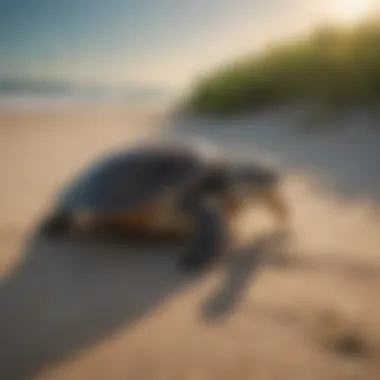
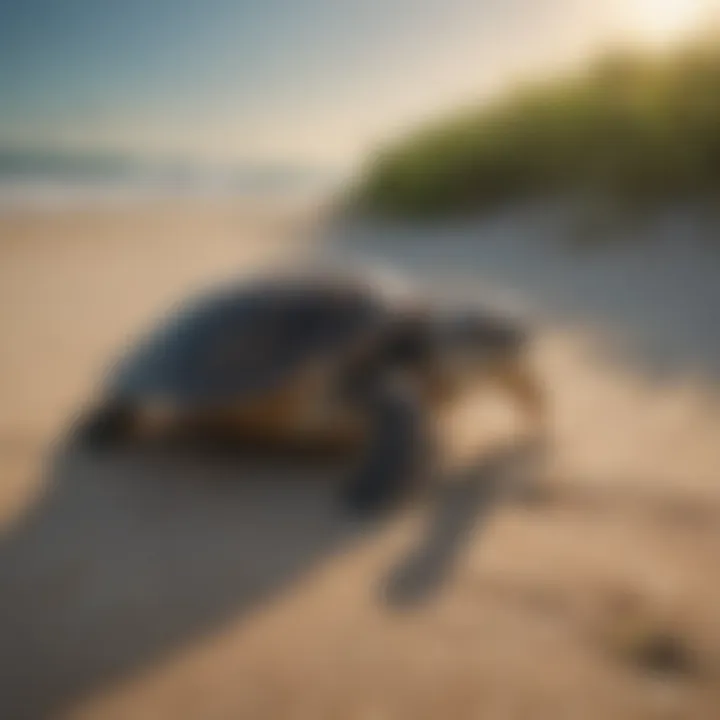
Factors Influencing Lifespan
The lifespan of sea turtles is not merely a product of their species characteristics; numerous factors interact to shape their longevity. Understanding these factors is essential for conservation efforts and ecological research. It highlights the delicate balance which influences sea turtle survival in their natural habitat. The implications of these factors stretch far and wide, affecting individual species as well as entire ecosystems. By examining the types of threats and environmental conditions, we can better appreciate and protect these ancient mariners.
Natural Predators and Threats
Predation plays a significant role in the early stages of sea turtle life. When sea turtles hatch, they are exceptionally vulnerable to predators like birds, crabs, and fish. During their journey to the ocean, young sea turtles face a grim reality. Many do not survive this crucial stage. Adult sea turtles also face threats from larger predators such as sharks, though their size provides them with some protection.
In addition to biological threats, environmental threats pose challenges. For example, pollution and habitat destruction significantly affect sea turtle populations. Pollutants may accumulate in their bodies, resulting in health issues. Furthermore, the increase in ocean plastic has been shown to impact their feeding habits and nutritional health.
Human Impact on Lifespan
Human activities are perhaps the most profound threat to sea turtle longevity. Coastal development, fishing practices, and pollution directly affect their natural habitats. For instance, bycatch in fishing gear can lead to accidental death for many turtles. The demand for turtle products, although illegal in many areas, continues to endanger certain species.
Moreover, climate change contributes to rising sea levels and altering habitats. Sea turtle nesting sites are at risk due to erosion and increased frequency of storms. Nighttime light pollution can disorient hatchlings, affecting their chances of reaching the safety of the ocean. The negative implications of human actions cannot be overstated; they fundamentally disrupt the natural cycles and survival strategies of sea turtles.
Environmental Conditions
The survival of sea turtles is also heavily influenced by environmental conditions. Ocean temperature, currents, and the availability of food sources impact their lifespan. Warmer water can affect breeding patterns and the health of the ecosystems on which sea turtles depend. Healthy coral reefs and seagrass beds are vital for their sustenance, and any disruption to these ecosystems can have dire consequences.
Furthermore, seasonal changes in prey abundance can affect feeding success. A sea turtle's ability to thrive is contingent on the health of its environment. Conservation efforts must consider not only the organisms but also the broader environmental contexts in which sea turtles live.
"The interactions of these factors define the fate of sea turtles, making it crucial for conservationists to adopt comprehensive strategies to safeguard their future."
By recognizing the interdependence of these influences on sea turtle lifespan, we can advocate for targeted strategies to promote their survival and wellbeing.
Mortality and Survival Rates
Natural Mortality Factors
Natural mortality in sea turtles can result from various factors. These include predation, disease, and natural disasters. Bacterial and viral infections can affect sea turtles, leading to weakened health conditions and ultimately death. Moreover, their young—from hatchlings to juveniles—face a higher risk of being preyed upon by birds, fish, and other marine animals.
Natural events, such as hurricanes and storms, also play a role. These can displace nests or harm habitats. Interestingly, certain species of sea turtles, like the leatherback, have adapted to survive longer in adverse conditions; however, this does not wholly negate the inevitable risk from their surroundings.
Natural mortality rates can vary significantly across regions, underscoring the need for localized research efforts.
Impact of Climate Change
Climate change presents one of the most pressing threats to the survival of sea turtles. Rising global temperatures can lead to shifts in nesting sites and food availability. Warmer sand temperatures at nesting beaches can influence the sex ratio of hatchlings, as sea turtle gender is determined by the temperature at which eggs are incubated. A bias toward one sex can ultimately threaten population viability.
Additionally, ocean acidification impacts the turtles' food sources. A decline in healthier habitats, such as coral reefs, affects the availability of essential food and, consequently, the health of sea turtles. Extreme weather events, associated with climate change, further elevate mortality during critical life stages.
Data on survival rates and mortality factors is crucial for robust conservation strategies. Monitoring changes in these statistics can help guide interventions to protect sea turtles effectively.
Conservation Efforts and Lifespan
The relationship between conservation efforts and the lifespan of sea turtles is paramount. Without effective conservation strategies, sea turtles face numerous threats that impact their life expectancy. These efforts not only aim to boost population numbers but also seek to create a sustainable environment conducive to their long-term survival. Understanding this relationship is crucial for anyone involved in marine biology, conservation, or environmental advocacy.
One significant aspect of conservation is habitat protection. Sea turtles rely on specific environments for breeding, feeding, and shelter. When these habitats are disrupted by human activity, such as coastal development, it can lead to decreased survival rates in both juvenile and adult turtles. Protecting nesting sites is particularly vital, as it directly influences the number of hatchlings that reach maturity.
Effective conservation also addresses legal measures. Laws that prohibit poaching and illegal harvesting ensure that sea turtle populations are not further diminished. Similarly, implementing regulations that minimize bycatch in fishing practices preserves a substantial number of turtles that would otherwise be unintentionally caught and killed. These legal frameworks are essential to promoting healthy populations in various species.
Additionally, education and public awareness play a crucial role in conservation efforts. By informing communities about the importance of sea turtles to marine ecosystems, locals can become advocates for their protection. Engaging in outreach programs can change perceptions and behaviors that threaten these creatures. Through educational initiatives, people learn to appreciate and protect their local marine life.
In summary, enhancing conservation measures has a profound influence on the lifespan of sea turtles. These efforts require collective action from individuals, organizations, and governments alike to ensure that sea turtles not only survive but thrive.
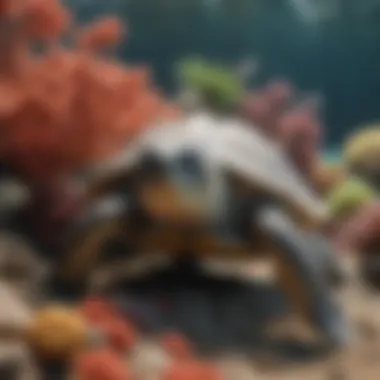
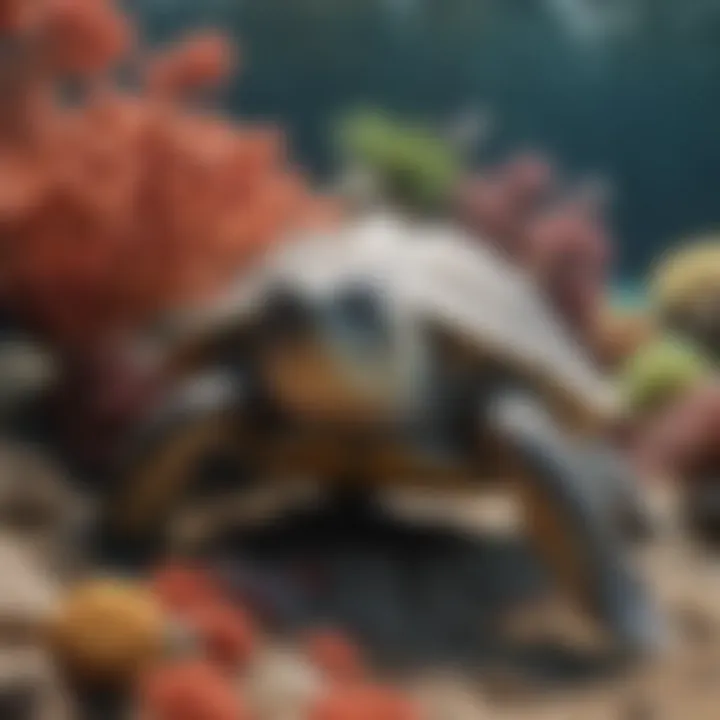
Importance of Conservation
The importance of conservation for sea turtles ties closely to their ecological role. Sea turtles are critical for maintaining healthy seagrass beds and coral reefs. Their grazing helps to promote the growth of these ecosystems, which in turn support a myriad of marine species. When sea turtle numbers decline, the balance of these environments can be disrupted, leading to negative consequences for other marine life.
Moreover, conservation initiatives help in stabilizing populations that are under threat. Specific endangered species, such as the Hawksbill turtle and the Leatherback turtle, are at risk of extinction without ongoing conservation efforts. Sustainable management practices can ensure these species remain part of our planet's biodiversity, which is essential for ecological resilience.
Key Benefits of Conservation:
- Biodiversity Preservation: Protecting sea turtles contributes to the overall health of marine ecosystems.
- Research Opportunities: Conservation efforts allow for extensive research, increasing knowledge about these species.
- Sustainable Tourism: Healthy turtle populations can enhance eco-tourism, providing economic benefits to local communities.
Current Initiatives
There are several current initiatives focused on enhancing conservation efforts for sea turtles. Organizations like the World Wide Fund for Nature and the Ocean Conservancy are at the forefront of these initiatives, adopting multi-faceted strategies to support turtle populations.
One of the most critical initiatives is the establishment of marine protected areas (MPAs). These areas are designated zones that restrict human activity to safeguard marine life, offering a refuge for sea turtles and other species. Within these areas, fishing, oil drilling, and coastal development are often limited, allowing habitats to recover and flourish.
Another significant initiative is the public engagement in hatchling releases. Many organizations engage local communities in the process of protecting nests and releasing hatchlings into the ocean. This hands-on involvement not only fosters local stewardship but also raises awareness and educates the public about the challenges these turtles face.
"Every sea turtle saved contributes to the ecological health of our oceans and the future generations of our planet."
International cooperation is also a key aspect of current conservation initiatives. Many sea turtle species migrate across national borders, requiring a collaborative approach between countries. Treaties such as the Inter-American Convention for the Protection and Conservation of Sea Turtles exemplifies how nations can unify their efforts to protect these animals.
Comparison with Other Reptiles
The lifespans of sea turtles can be best understood by comparing them with other reptiles. This comparison provides valuable insights into the ecological and biological factors that contribute to longevity. Sea turtles, as reptiles, share some similarities and differences with their terrestrial relatives like land turtles and tortoises. Understanding these differences can shed light on the adaptations that influence their life expectancy and offer clues about the environmental conditions that support their survival.
Lifespan in Comparison to Land Turtles
Sea turtles generally boast longer lifespans compared to most land turtles. While many terrestrial species might live for decades, certain sea turtles can live up to 80 years or more in favorable conditions. For example, the Galápagos tortoise can live well over a century, but many other turtles have a lifespan averaging between 20 to 50 years. In contrast, species like the leatherback sea turtle and green sea turtle often reach ages greater than 50 years.
This difference can be attributed to several factors, including:
- Habitat: Sea turtles inhabit vast oceanic spaces, which might protect them from certain land-based predators. However, they face different threats, such as fishing nets and marine pollution.
- Reproductive Strategies: Many sea turtle species have adapted to reproduce multiple times over their lifespan, allowing for the possibility of a longer life.
- Environmental Factors: Changes in the environment, including ocean temperatures, can impact sea turtle development and longevity.
Adaptations Influencing Longevity
Adaptations play a crucial role in determining how long sea turtles live. A few significant adaptations include:
- Size: Many sea turtle species are larger than land turtles, making them less vulnerable to certain predators. Larger animals generally have fewer natural enemies, which could positively affect their lifespan.
- Physiology: Sea turtles possess physiological adaptations that allow them to thrive in their oceanic environment. Their bodies are designed for longevity; for instance, some can hold their breath for extended periods, reducing encounters with predators.
- Migration Patterns: Sea turtles migrate over long distances to find feeding and breeding grounds. This ability helps them avoid localized threats, thus increasing their chances of survival.
"Understanding the adaptations that influence the lifespans of sea turtles is essential not only for their conservation but for preserving marine biodiversity overall."
In summary, the comparative analysis between sea turtles and land turtles highlights essential ecological and biological considerations. The differences in their lifespans stem from adaptations suited for their unique environments and challenges. Studying these differences not only enriches our knowledge but may also guide effective conservation strategies for both sea turtles and their terrestrial counterparts.
Ending
Summary of Insights
The insights accrued from the exploration of sea turtle lifespans reveal much about their ecological role and vulnerability. Sea turtles, in their long lives, endure various threats from natural predators, environmental changes, and human activities. Key takeaways include:
- Lifespan Variation: Different species exhibit varied life expectancies, ranging from a few decades to over a century.
- Life Cycle Understanding: The transition from hatchling to reproductive maturity involves numerous challenges, impacting survival rates and ultimately lifespan.
- Human and Environmental Influence: Factors such as habitat destruction and climate change significantly affect the longevity of sea turtles.
- Conservation Necessity: The crucial importance of conservation initiatives becomes evident to help these gentle creatures thrive in their natural habitats.
The amalgamation of these insights emphasizes the need for continued research and conservation strategies to ensure that sea turtles can live out their full potential in the wild.
Future Research Directions
Future research on the average lifespan of sea turtles should address several critical areas:
- Impact of Changing Climate: Investigating how climate change specifically alters the lifespan of different sea turtle species, particularly in relation to nesting sites and food availability.
- Longitudinal Studies: Conducting long-term studies to track individual sea turtles throughout their life cycles, providing valuable data on their growth, reproduction, and survival.
- Effect of Conservation Strategies: Assessing the efficacy of current conservation efforts in promoting longevity among various sea turtle populations.
- Genetic Factors: Exploring genetic predispositions that may influence lifespan, offering deeper insights into the adaptations of sea turtles.
These future research directions are essential for building a comprehensive understanding of the factors that influence the longevity of sea turtles, thereby fostering effective strategies for their protection and conservation.



